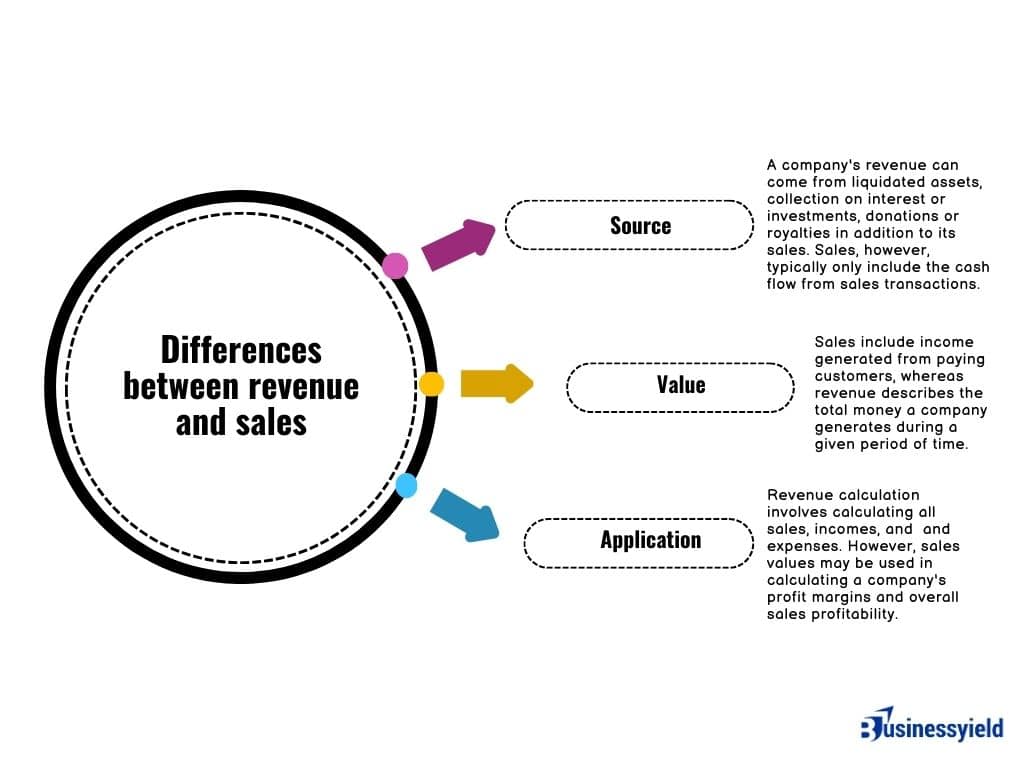When you think of revenue vs sales, do you wonder what the similarities and differences are? Well, it is pretty straightforward; revenue is the total income a company generates from selling goods or services that can be attributed to the company’s core operations.
Sales, on the other hand, are simply the proceeds a company generates from selling goods or services to its customers.
Due to their similarities, some companies inaccurately use the terms sales and revenue interchangeably. However, just because it looks straightforward on the surface doesn’t mean the difference between revenue vs sales is that simple. For one, all sales can be classified as revenue, but not all revenue is sales.
Confused yet? Don’t panic; it will become clearer as we go on.
Key takeaways
Both revenue and sales are used as the same, but can be easily differentiated in accounting terms.
Revenue can be calculated by adding sales with other income the company generates, whereas sales can be calculated by multiplying the total goods/services sold with its price.
Revenue shows a company’s resourcefulness in generating money, whereas sales show its ability to sell its products/services.
Revenue can exist without sales, but sales automatically turn into revenues.
What is revenue?
Revenue refers to a company’s total income from sales, incoming assets or even cashing out on an investment. While it can account for a business’s sales, a business’s revenue may include income from other sources in addition to its sales. Additionally, revenue can be tracked as a company’s gross revenue and net revenue, similar to tracking sales.
Here are some of the most common types of revenue:
Gross revenue
A business’s gross revenue is the total income earned from sales as well as non-operational income before any deductions and cost subtractions are made.
Here is an example:
Let’s assume Jay’s Hardware, an equipment and tool retailer, measures its total gross revenue for its quarterly reporting period. The company would combine all income sources from its total sales, investments, and any assets or interest accrued for the period. Jay’s Hardware’s income statement could look something like this:
- Total product sales: $60,000
- Equipment rentals: $5,400
- Collected interest on credit accounts: $18,000
- Liquidated assets: $20,000
From the above, the company’s total revenue is $103,400. Jay’s Hardware could then further break this value down by subtracting overhead, costs of goods sold, and its other expenses to get its net revenue.
Net revenue
Net revenue is a company’s total revenue after it has subtracted all its expenses, including costs of goods sold and overhead (rent, utilities or payroll). This accounts for all expenses that are directly related to sales operations as well as its liabilities for credit payments, rent or mortgage, utilities and other overhead costs for maintaining the overall business.
Using the above example of Jay’s Hardware, let’s see how it would calculate its net revenue:
Using the quarterly gross revenue value of $103,400, Jay’s Hardware subtracts its expenses to get its net revenue. Additionally, the company’s overhead expenses include warehouse storage fees, equipment maintenance, employee payroll and operational costs like utility bills and rent. Its income statement might look like this:
- Cost of goods sold: $10,000
- Equipment storage: $5,000
- Rent and utilities: $12,000
- Payroll: $18,000
- Equipment maintenance fees: $1,500
So the total expenses Jay’s Hardware incurred for the quarter resulted in $46,500. Subtracting this value from the gross revenue will give Lee’s Hardware a net revenue of $56,900 for the quarter.
You should note, however, that while gross and net sales can be calculated similarly, the value of your company’s sales typically does not account for non-operational income like collecting on interest or investments, donations, and other incomes that a business might obtain outside of sales.
Non-operational revenue
A company’s total revenue can also include non-operating revenue, such as cash acquisitions on interest and investments, liquidated assets, and even royalties and donations. A company’s non-operational revenue may also include one-time event gains like the collection of litigation sums and fees. Companies may also collect government revenue as a non-operational income if they receive refunds on quarterly or yearly taxes.
Sales formulas can generally work the same way, however, calculating gross and net revenue encompasses all incoming and outgoing cash flow and is not limited to the cash flow of a business’s sales.
Below is a checklist of steps you can follow to calculate your company’s revenue:
How to calculate revenue
What is sales?
A company’s sales refers to the revenue it generates from selling its products or services to customers. Unlike revenue, a company’s sales values only account for incoming cash flow directly related to processing the sale of its goods or services. They are considered a subset of the total revenue a business generates.
As sales is one component that can make up a business’s revenue, it can be further split into values for gross sales and net sales. Additionally, companies may include net sales along with total revenue on their income statements.
Here are the different categories of sales:
Gross sales
This accounts for a business’s total income from its sales minus the cost of goods sold directly related to producing or otherwise supplying its products and services. Gross sales can also be used to calculate the total revenue, which is why a company’s sales are considered a subsection of its revenue.
Let’s look at an example.
Assuming your company calculates its total yearly sales at $600,000, with the cost of goods sold (COGS) for the same yearly period totaling at $150,000. You would calculate your gross sales using the formula
(gross sales) = (total sales) – (COGS).
Gross sales = ($600,000) – ($150,000) = $450,000.
You can then calculate your net sales by subtracting operating expenses and other sales-related costs from the gross sales.
Net sales
Net sales is the value of a business’s total sales profit after all costs of goods sold and operating expenses are deducted. This value can be an important financial tool for measuring a business’s sales profitability because it can tell companies how profitable and in-demand their products and services are.
Using the same example above, let’s determine how you will calculate your net sales. You might subtract your operational expenses like the outgoing cash flow from product returns and refunds, rebates, or discounts. In this case, you will add this total to your balance sheet:
- Product refunds: $45,000
- Product rebates: $30,000
- Discounts Total: $15,000
To calculate the net sales, you will combine all expenses and cost of goods sold and subtract this amount from your gross sales using the formula:
(net sales) = (gross sales) – (expenses).
Net sales = ($450,000) – ($90,000) = $360,000.
You can then add this value to its total revenue.
You should also note that sales profitability, or the business’s gross profit margins, may only give insight into how profitable your business’s products or services are. Total revenue, conversely, offers information on the whole financial health of your business.
Below is a checklist of steps you can follow to calculate your company’s sales:
How to calculate sales
Revenue vs sales: Key differences
Consider the following financial data from Exxon Mobil Corporation’s (XOM) income statement for the quarter ending June 30, 2019:
- Sales and operating revenues were roughly $67.5 billion for June 2019 versus $71.5 billion for June 2018.
- Total revenue was $69 billion for the quarter ending June 2019 and $73.5 billion for the same period in 2018.
- Revenues from other sources such as equity affiliates totaled more than $1.5 billion in 2019 and $2 billion in 2018.
The difference between revenue and sales is relevant to investors viewing company reports.

A company’s sales indicate the performance of its core business operations, while its revenue may be padded with one-time events like sales of property.
Whether it’s sales, gross sales, net sales, or revenue, it’s critical to consider the industry in question, when analyzing a company’s financial data. It’s also important to distinguish between sales and revenue, because some revenue sources may be one-off events.
Here are some key differences between revenue vs sales:
Source of revenue vs. sales
The sources of a company’s income differ between revenue and sales. For instance, a company’s total revenue could account for income from liquidated assets, collection on interest or investments, donations or royalties in addition to its sales.
The sources of income for a company’s sales, however, typically only include the cash flow from sales transactions.
Value of revenue vs. sales
Sales include income generated from paying customers, whereas revenue describes the total money a company generates during a given period of time. Consequently, revenue is commonly the greater amount. However, when sales income results in a greater value than the total revenue a business generates, it can mean the business has incurred more costs or expenses.
The difference in value between revenue and sales can contribute to fluctuations in the net incomes.
Applications of revenue vs. sales
The uses for revenue and sales calculations can also differ slightly. When a company applies revenue calculations, it usually calculates all sales, non-operational incomes, and operational and non-operational expenses to provide essential information about its overall financial standing.
However, the sales values may be used in calculating a company’s profit margins and overall sales profitability.
Revenue vs. sales: head to head
Here are the main differences between revenue vs. sales:
| Basis of comparison between Revenue vs. Sales | Revenue | Sales |
|---|---|---|
| Meaning | The total amount of money generated by the company | Sales can be calculated by multiplying the total goods/services sold by its price. |
| Calculation | Revenue is calculated by adding sales with other income. | Sales can be calculated by multiplying the total goods/services sold with its price. |
| Indicates | the company’s ability to invest and allocate its resources to maximize the earning potential | Indicates a company’s capability of selling its primary goods/services to make a profit |
| Example | If sales of XYZ is $20,000, and income from other sources is $5,000, then revenue would be $25,000 | If products sold by XYZ are 2,000, and the price per product is $10 per product, then sales would be $2000. |
Revenue vs sales: Final thoughts
As you can see, sales and revenue aren’t the same, even if they are used interchangeably.
When you are just starting your company, it has almost no existence in the market. That’s why staying afloat involves generating money from several sources so that you can create products/services and sell them. Hence, sales often come when the company has the money to manufacture products/ buy products at a lower price.
On the other hand, revenue is a culmination of all sources of income (investments, consulting, interest received, fees charged, etc.) and the amount collected because of sales.
Both revenue and sales are key income values that companies use to measure overall financial standing and profitability. Understanding how sales income can influence overall revenue can help you stay current and achieve financial success.
Recommended Articles
- REVENUE BASED FINANCING: Definition, Types & Methods
- How to Get into Medical Sales With No Experience
- 7 Tried And Tested Marketing Strategies To Drive Revenue
- Inside Sales vs Outside Sales: Ways to Balance the Roles for Growth
- UNEARNED SERVICE REVENUE: Definition, Examples & Calculations
- What the Challenger Sales Model Is and How to Use It for Better Outcome
- Choosing Upselling & Cross-selling Strategies to Strengthen Your Sales Approach






